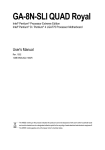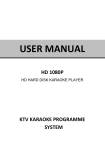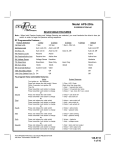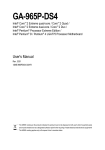Download 1622192 ENG Argo1+2motori Rev14
Transcript
ARGO 1 - ARGO 2 SERIES SWITCHBOARDS, PROGRAMMABLE FOR 1 OR 2 MOTORS WITH INDEPENDENT SLOWDOWN CONTROL IMPORTANT: DO NOT INSTALL THE SWITCHBOARD BEFORE READING THE INSTRUCTIONS!!!! 1. Introduction. The Argo control unit is an apparatus fit to manage operation and control of 1 or 2 wing gates with 230V AC motors and power of up to 600W each. The time functioning of the control unit, being of electronic type, is extremely precise. It is however possible that, due to the type of the motor normally utilised, the corner of the travelling time of the wing is strongly influenced by the frictions that the wing self meets during the course. Consequently , also if the time is correctly set, the corner of the wings’ opening can not be always the same wished. Therefore it is advisable that the installer considers it, increasing, if necessary, the times of work in the more consonant measure with the installation and making anyway attention to the fact that an excessive increasing of the time could mask the slowing down in opening and in closure (see paragraph 6). For the correct functioning it is also necessary the installation of the mechanical stops in opening and in closure (see pag. 6). 2. Configuration. Connector transformer Trimmer of regulation Molex radio module Learning button Fuse Connector radio module Dip-switch 3. Electrical connections. Electrolock output 12 Vac 12W Max Table of contents: Indicator of open gate 24 Vac 2W max. Photocells power supply (see par.7.6) Any control or safety device designed for acting as a Normally Closed (N.C.) contact, must be provided with a jumper, if not used. Power supply 230 Vac 50 Hz. Flashing light 230 Vac 60W max Motor 2 6-1622192 Motor 1 REV.14 30/07/2012 FOTO CH = Photocell closing FOTO AP = Photocell opening AP = open CH = close Com = Common PP = step by step button Ant = Antenna PED = Pedestrian button F.C. 1 = limit switch 1 F.C. 2 = limit switch 2 3 4 5 6 7 8 9 10 11 12 N.B.: Use flashing light B.RO LIGHT FIX. (Without autoflashing circuit) ITA ENG FRA ESP DEU POR 1/9 SAFETY WARNINGS • Some points of the electrical card are under voltage. Therefore, the installation, the opening and the programming of board have to be done only by qualified staff. All the operations executed by the user do not require box opening. • Providing the use of a device that ensures omni polar disconnection of power from the control unit. This device may be or an interrupter (directly connected to the power terminals) with a minimum distance of 3 mm. between the contacts in each pole, or a device integrated into the power network. For connecting the card and the motors, we recommend to use cable with double isolation as provided through restrictions and in any case, individual conductor must have a minimum cross section not less than 1mm² and not more than 2.5mm². The manufacturer declines all responsibilities for no compliance with these warnings. • • • This central unit is furnished with a test circuit for the photocells. For wiring these photocells, see diagram on page 5. • It is recommended to check the absorptions of all devices connected to the output of control unit, such as warning lights, photocells, safety devices and so, according to their limits established on the table of technical features. • The correct functioning of the product is not guarantee in case of non-observance of these limitations. • To maximise the transmitter reach, it is not necessary to pay attention to the placing of the receiving antenna: it must not be positioned near walls and/or metallic shields. The terminals on shielded cable of the antenna have to be tightly closed. • The corded antenna is necessary for obtaining the highest equipment capacity, otherwise the reach would be reduced to a few meters. 4. Factory settings. The control board is supplied with the dip.switch set as indicate on the figure beside. In the table are resumed the functions selectable by these dip-switch. N° dip Function Dip OFF Dip ON 1 Step-by-step Open-stop Close-stop Open-Close 2 Water hammer Enabled Disabled 3 Photocells movement stops arrest and reversal of motion 4 Pre-blinking Active Active 5 Condominium function Not active Active 6 Safety control Enabled Disabled 7 Limit switch operating mode In Closing End of operation Start of slowdown In closing 8 Limit switch operating mode In Opening End of operation Start of slowdown In opening 9 *** *** *** 10 Immediate Automatic re-closing Disabled Enabled N° dip Function Dip OFF Dip ON 1 Step-by-step Open-stop-Close Open-Close 2 Water hammer Enabled Disabled 3 Photocells movement stops arrest and reversal of motion 4 Pre-binking Not active Active 5 Condominium function Not active Active 6 Safety control Enabled Disabled 7 Limit switch operating mode End of operation Beginning of slowdown Slowdown functioning mode (only if dip 7 is ON) Start of slowdown on limit switch in OPENING Start of slowdown on limit switch in CLOSING Slowdown functioning mode ( only if dip 7 is OFF) End of operation Limit switch not connected 9 Open gate Symmetrical Asymmetrical 10 Immediate Automatic re -closing Disabled Enabled 8 5. Self-lerning transmitter. The self-learning procedure of every individual transmitter must always be carried out with the gate closed, 5.1 Memorization of the transmitters / of the transmitter of preparation 4 channels Pressing and releasing the learning taste turn on the flashing light; so, transmit with the transmitter to learn, considerino that: • The tastes must be learned one by one • • • • TRANSMITTER With the first button learned “a”, the step-by-step order is given. PP With the second button learned “b”, the “pedestrian” command is imparted. DOWN With the third button learned “c”, the DOWN command is given. a b c d PEDESTRIAN UP With the fourth button learned “d”, the UP order is imparted. It is advisable to learn the a, b, c, d keys sequentially. When an UP or DOWN button is activated while imparting the instructions (the “c” or “d” button over the transmitter), the blinking light will flash briefly for indicating that the key was seen from the system. It is very important to verify that each transmission of all the buttons is correctly received by central unit. NOTA: The successive learning can now be executed also with the memorized transmitter. The operative modalities are reported here following: 6-1622192 REV.14 30/07/2012 ITA ENG FRA ESP DEU POR 2/9 5.2 Using the hidden key of an enabled transmitter already learnt. Push the hidden taste “e” ab cd led ab led Function active only with B.RO rolling code models 1. Using a staple, press the hidden button of a transmitter already learned. The learning function is pointed out when the blinking light switches on. 2. Press the key of the transmitter you prefer to memorize; the flasher will blink (twice with a new code, once if already learned). The central unit returns to his normal functioning state and the new transmitter can activate the motor. 5.3 Using an enabled open memory transmitter. ab Flashing light ab Flashing light Function enabled only with B.RO models with rolling code and removable memory only 1. Press any “memory open” key on the transmitter previously enabled by using the B.RO PRO or B.RO BASIC ming tool. The receivers enters in self-learning modality (the light starts to blink). 2. Press the button of the transmitter you wish to enable; the light blinks twice with a new code, once if already learned. The control unit comes back to his standard mode and the new transmitter is now ready for operation. 5.4 Transmitters deletion and production values setting. Accendere + Premere auto apprendimento led 1. Disconnect power supply. 2. Supply power by keeping pressed the self-learning key for further 4-5 second. All codes are delated and the flashing light turns on for a total time of approximately 10 sec. When the blinking light switches off, all transmitters are deleted and the memory module is prepared to receive the fixed code or the rolling-code, depending on how Jumper is setting. 6. Regulation. 6.1 Gate movement regulation. It is possible to regulate the gate motion by appropriately using of special trimmers (“WORKING TIME”, “A.RECL.TIME”, “2nd:WING D.”) and selecting the setting up of the DIP-SWITCH, according to the type installation and needs of the wireman. As you may note from the figures below, the trimmers have a range from 0° to 270° where inside, the desired regulation can be obtained with good precision. - + - + 0° 0° 270° 0° 270° WORK TIME A. RECL. TIME Working time regulation Automatic re-closing time regulation - + 0° 270° 2nd: WING D. ARGO 2: Delay and working time regulation of 2nd wing ARGO 1: Opening pedestrian time regulation. In the last part of its movement (opening and/or closure), the gate winds slow down proportionally to the work time setted (“WORKING TIME“ for the symmetrical gate, “WORKING TIME” and “2nd:WING D.” for the asymmetrical one). It is possible to disactivate the slow-downs or adjusting the slow-down phase as described in sections 11.C e 11.D. In symmetrical gates it may be necessary to insert a delay time in the second gate wind i(closing phase). Select dip-switch 9 OFF position and regulate this time delay by the “2nd: WING D” trimmer . In the case of Argo 2 motors, for asymmetrical gates there is the possibility to define working time for second wing differently from the first one wing. Select dip-switch 9 ON position and regulate working time of second wing by the “2nd: WING D“ trimmer. By cutting the bridge indicated in the figure, it is possible to increase the working time. - - + + Shifting time 0° 7” 0° 55” 55” WORK TIME WORK TIME - The trimmer settings, made during the gate movement, haven’t any immediate effect. They become effective only after the stop of the gate or after the switching off and the following switching on the central unit. REV.14 30/07/2012 - + + Shifting time 0° 7” IMP.The increase of the working times does not influence on the automatic reclosure time and on the pedestrian time 6-1622192 2’10” 55” 55” 0° 2nd: WING D. ITA ENG FRA ESP 2’10” 2nd: WING D. DEU POR 3/9 6.2 Torque adjusting of the motor. The control unit Is furnished with a trimmer for adjusting the torque supplied to the motor, in order to limit the force of gate against some obstacles that might get in the way during motion (for ex. poor/fair functioning of photocells). POWER For regulating the torque applied by the motor, proceed as follows: • Act on trimmer regulation to set the torque desired, keeping in mind that the trimmer is at the minimum level when located in the extreme counter-clockwise direction and at the maximum level when located in the extreme clockwise + direction. • Start up the motor and check the torque. 270° • If the regulation is not adecuate, stop the movement and fit the trimmer again, than start up the motor again. 0° • Is advisable to check the torque before regulating the gate movement. 6.3 Automatic re-closing function. A. RECL. TIME The automatiic re-closing function is an operation that enables the automatic re-closing of gate when the pause time selected by the “A. RECL. TIME” is over. + The enabling or disabling of function is given from the same trimmer, that is: • Defining the whole trimmer for extreme counter-clockwise (minimum), the automatic re-closing is disabled. • 270° 0° Defining the whole trimmer for clockwise, on introduct the automatic re-closing. NOTA: The successive learning can now be executed also with the memorized tranmitter. The operative modalities are reported here following. 7. Funzioni selezionabili tramite DIP-SWITCH. It is important to change the configuration of the dipswitch only with power down. 7.1 Step-by-step function. 1 1 2 2 3 3 4 4 5 6 5 6 7 7 8 8 ON OFF The unit automatically carries out an open-stop-close-stop sequence. ON OFF The unit automatically carries out an open-close-open-close sequence. 9 10 9 10 It is possible to change the way the control unit responds to commands given by the remote control or step-by-step key (pulse button): Step-by-step order may be given by a special input (see pulse switch on terminal block), or by pushing the first key of a memorised transmitter (see section 5 learning transmitter). 7.2 Water hammer. If the automation mechanism provides for an electric lock and this is enabled, when the gate is closed, it is advisable for the motor to operate in closing state for a shortly period before starting the opening one. This function makes it possible to open the electric lock in any case, even in bad weather conditions (such as in the event of ice). ON OFF 1 2 3 4 5 6 7 8 9 10 ON OFF 1 2 3 4 5 6 7 8 9 10 Water hammer is active for opening stage and the electrical lock is controlled through the control unit. The default cycle provides for a minimum water hammer during the opening phase and for no water hammer during the closing one, which may be modified as described in paragraph 8.1. Water hammer is disable but the electrical lock is still active ( this is very usefull when a magnetic lock is present). 7.3 Safety and protection photocells. When an obstacle interfers with the beam emitted by the transmitter and receiver photocells, the sames modify control unit condition as follows: ON OFF 1 2 3 4 5 6 7 8 9 10 ON OFF 1 2 6-1622192 3 4 5 6 REV.14 7 8 9 10 30/07/2012 A) during the gate opening cycle : if photocells detects an obstacle, the central unit stops the gate. When the obstacle is removed, the door OPEN cycle resumes until the door is open fully. B) during the gate closing cycle: if photocells detects an obstacle, the central unit stops the gate. When the obstacle is removed, the door OPEN cycle resumes until the door is open fully. A) during the gate opening cycle: if photocells detects an obstacle, the gate motion continues B) during the gate closing cycle: if photocells detects an obstacle, the central unit blocks and invertes the direction of gate until it is totally opened. ITA ENG FRA ESP DEU POR 4/9 7.4 Pre-blinking function. This light flashes slowly (approximately once every two seconds) to warn the opening gate and quickly (approximately once a second) to warn closing gate. 1 1 2 2 3 3 4 5 6 4 7 5 6 8 7 8 ON OFF Pre-blinking function disabled ON OFF Pre-blinking function enabled. The gate motion is always signalized by a pre-blink, advising the user that the gate is ready to start. Pre-blinking time is fixed for 2 seconds approximately. 9 10 9 10 7.5 Condominium function. All inputs given remotely or by using the pulse button only open the gate. The door closes again automatically and as result, the automatic reclosing function has to be actived, because the close command is ignored from the system (the close key is disabled). 1 1 2 2 3 3 4 4 5 6 7 5 6 7 8 8 ON OFF Condominium function disabled. ON OFF Condominium function enabled. 9 10 9 10 7.6 Photocell test. Every time the motor is switched on, the control unit automatically controls if the photocells are functioning properly. This operation increase the security system if a photocell is damaged (for instance output relay stuck) or in case of undesired photocell input short circuit. This test is executed after the control unit has received an order of “moving“, but before power is applied to the motor. Installation notes: Power supply to ALLMATIC photocells, or compatible types, must be connected to different terminals, depending on wheter it is necessary to activate or de-activate testing on the photocells. The correct wiring diagram for a couple of photocells is the following: 13 14 15 13 14 15 DIP6 OFF: Photocells test enabled. The command is not performed if the photocells are faulty. DIP6 ON: Photocells test disabled. 24 24 TX RX TX Wiring diagram with photocells TEST ACTIVE (DIP6 OFF) Note: If the photocells test is active, the motor is delayed by approximately one second from the moment in which the order is received. 24 24 RX Wiring diagram with photocells TEST NOT ACTIVE (DIP6 ON) 7.7 Methods for limit switch interventions. The end of the opening and closing operations is entrusted to the set operational time and setting of dips 7 and 8. NOTE: if limit switches are not installed, place dip 7-OFF and dip 8-ON: ON OFF 1 2 3 4 5 6 7 8 9 10 7.7.1 Model ARGO2: If limit switches are installed, these operate in the following ways: ON OFF 1 2 3 4 5 6 7 8 9 10 ON OFF 1 2 3 4 5 6 7 8 2 3 6-1622192 4 5 6 REV.14 7 Function Limit switch 1 End opening operation Limit switch 2 End closing operation Type of limit switch Function Limit switch 1 No operation Limit switch 2 End closing operation Type of limit switch Function Limit switches 1and 2 positioned for opening Start of slowdown in opening Closing limit switch No operation 9 10 ON OFF 1 Type of limit switch 8 9 10 30/07/2012 ITA ENG FRA ESP DEU Arrest with limit switch: the end of the opening (limit switch 1) or closing (limit switch 2) operations determined by the corresponding limit. Arrest without opening limit switch: only the closing selection is defined by time intervention of the corresponding limit switch. Start of slowdown only in opening: the start of slowdown phase in opening is set off by the intervention of both limit switches (one for each wing), while it is only timed in closure (see diagram below) POR 5/9 Type of limit switch Function ON OFF 1 2 3 4 5 6 7 8 Opening limit switch No operation Limit switch 1 and 2 positioned in closing Start of slowdown In closing Start of slowdown only in closing: the start of slowdown phase in closing is set off by the intervention of both limit switches (one for each wing), while it is only timed in opening (see diagram below). 9 10 FC 1 FC 2 Conceptual diagram of limit switch functions FC 1 Limit switch 1 and 2 placed for slowdown in opening FC 2 Limit switch 1 and 2 placed for slowdown in closing 7.7.2 Model ARGO1: If limit switches are installed, these operate in the following ways: ON OFF 1 2 3 4 5 6 7 Type of limit switch Function Closing limit switch End closing operation 8 9 10 ON OFF Start of slowdown in closing Closing limit switch 1 2 3 4 5 6 7 8 9 10 ON OFF 1 2 3 4 5 6 7 8 9 10 ON OFF 1 2 3 4 5 6 7 Type of limit switch Function Opening limit switch End opening operation Opening limit switch Start of slowdown in opening 8 9 10 7.8 Symmetrical / asymmetrical opening (ONLY FOR ARGO 2 MOTORS ). ON OFF 1 2 3 4 5 6 7 8 9 10 ON OFF 1 2 3 4 5 6 7 8 With dip-switch in this position, the gate opens/closes symmetrically (one operational time for both wings to set using the “WORKING time” trimmer). With dip-switch in this position, the gate opens/closes asymmetrically (different operational time for the two wings to set respectively with the “WORKING TIME“ e “2nd: WING D“ trimmers). 9 10 Mechanical stops opening Mechanical stops opening Mechanical stop opening Mechanical stop closing Mechanical stop closing Anta B Anta B Anta A Symmetrical Esemp io di opening. funzionamento simmet rico: Opening door Aanta = opening time di door B Tempo time di apertura A = Tempo apertura anta B Anta A Esempi o di fu nzisituation onamen to asim met rico: Asymmetrical Tem po di aperttime ura andoor ta B > d i apertura a nta Opening B >Tempo opening time door AA Tem po di aperttime ura andoor ta A A > >Tempo d i apertura a nta Opening opening time door BB 7.9. Immediately re-closing after photocells intervention. This selection provides to closing the gate after an interruption of photocells beam. If a break time was estimated, the countdown is stopped and the gate closes. 1 1 2 2 3 3 6-1622192 4 4 5 6 5 6 7 7 REV.14 8 8 ON OFF Re-closing after a stop in photocells beam disabled. ON OFF Re-closing after a break in photocells beam enabled. 9 10 9 10 30/07/2012 ITA ENG FRA ESP DEU POR 6/9 8. Additional variations. If the water hammer or the electronic locking activation are not matched with gate characteristics, these may be modified inserting the learned instruction that follow. These instructions are carried out with a 4 button transmitter, in which all the keys have been learnt by the central unit. To enter the learning function, the gate must be closed. 8.1 Water hammer timing change. If the operation timing of water hammer does not meet gate requirements you are automating, there is the possibility to change it through the following procedure. TRANSMITTER The activation sequence for present learning menu is the following: PP DOWN a b c d PEDESTRIAN UP 1. Close the gate by means of a step-by-step order. 2. Once the gate has stopped moving and the flashing light is off, press the UP key (the blinking light signals reception of key by a brief flashing), then release the same. 3. Press the DOWN key (the blinking light signals reception of key by a brief flashing), then release the same. 4. Press the UP key (the blinking light signals reception of key by a brief flashing), then release the same. Learning (n° UP/DOWN) Water hammer in opening Water hammer in closing Default Minimum Null 1 Minimum Minimum 2 Minimum+ 0,1 sec. Minimum + 0,1 sec. 4 Minimum + 0,3 sec. Minimum + 0,3 sec. ... ... ... DOWN UP The entering into learning menu for the water hammer timing, is confirmed by the blinking light with a 1 flash and 1 pause sequence. By pressing theUP key, you define an increase in water hammer timing by approximately 0.1 seconds each time is pressed, where as by pressing the DOWN key, you determine a decrease in water hammer timing by approximately 0,1 seconds each time is pushed until the default value. To exit from learning modality, is sufficient to convey a Step-by-Step command. The table below gives the possible variations. 8.2 Variation of electric lock timing and consequent second wing opening time delay. If the time lag set for second wing opening not meet the requirements of the gate you are automating (as for example in the event of asymmetrical wings), it is possible to change it through the reported procedure. The activation sequence for present learning menu is the following: 1. Close the gate by means of a step-by-step order. 2. Once the gate has stopped moving and the flashing light is off, press the UP key (the blinking light signals reception of key by a brief flashing), then release the same. 3. Press the DOWN key (the blinking light signals reception of key by a brief flashing), then release the same. 4. Press the UP key ((the blinking light signals reception of key by a brief flashing), then release the same. The entering into learning menu for the electric lock activation timing with consequently wing opening time delay, is confirmed by the blinking light with 1 flash and 1 pause sequence. By pressing the UP key, you define an increase in the electric lock activation timing (and consequent second wing opening time delay in 2 motor versions) by approximately 0.1 seconds each time is pressed, whereas by pressing the DOWN key, you determine a decrease in the electric lock activation timing by approximately 0.1 seconds each time is pushed. To exit from learning modality, is sufficient to convey a Step-by-Step command. 8.3 Disactivation of slow-downs. In some situations is advisable to eliminate slow-down phase of the gate; first of all, you have to take off power to control unit and consequently cut off the short circuit bridge near the LEARN key, as noted in this figure: Then, powered once again the switchboard. After this operation, the central unit do not execute slow-downs (neither in opening nor in closing phase): therefore, the phase that first occured with a reduced velocity will be realised at the same one of standard work. Verify movement gate as it might be necessary re-calibrated. For enable again the slowdowns, is necessary to set up the short circuit bridge. 6-1622192 REV.14 30/07/2012 ITA ENG FRA ESP DEU POR 7/9 8.4. Adjustment returned motion. Once performed movement gate regulation, it is possible that the point in which the wings stop the opening phase does not correspond to the one programmed. Two situations may be presented: 1. Wings opening-corner, equivalent to opening gate condition, DECREASE to each reversal motion and/or by intervent of photocells. 2. Wings opening-corner, equivalent to opening gate condition, INCREASE to each reversal motion and/or by intervent of photocells.In these cases is at your disposal a procedure for adjusting gate movement, in order to obtain better condition of the same.Starting from one situation in which your gate is closed and stopped, the activation sequence for this learning is: 1. Press the UP key (the blinking light signals reception of key by a brief flashing), then release the same. 2. Press and release for 3 times the DOWN key. Every button learned is signalized by the blinking light with a brief flashing. 3. Press the UP key (the blinking light signals reception of key by a short blinking), then release the same. The entering into learning menu is confirmed by the blinking light with a 3 flashes and 1 pause sequence. To exit from learning modality, is sufficient to convey a Step-by-Step command. If wings do not open totally, INCREASE slowing down phase by pushing DOWN button. Please note that each pressure of DOWN key causes an increase in slowing down phase. If wings open too much, DECREASE slowing down phase by pushing UP button. Please note that each pressure of key UP cause a decrease in slowing phase. At this point is advisable to check gate motion, as the wings will open more or less according to the execution of this learning. Try to perform two or three inversions and verify if your gate keeps his position, otherwise, decide if you have to repeat the procedure described. NOTE: Before carring out any modification, control that other selections (working time, torque …) are suitable for the gate you are automating. The reset memory operation readecuate this value to the feature production. 9. Reception mode selection. The switchboard is designed to be used with two types of transmitters: conventional set code transmitters (i.e. AEMX, AKMY) and the most innovative, rolling code transmitters in the Birol® series (i.e. B.RO4WN, B.RO STAR and the BRO4K quartz series). 1 2 3 If transmitters of the fixed code series are used, place Jumper J1 in the 2nd-3rd position. 1 2 3 With rolling-code transmitters, place Jumper J1 in the 1st-2nd position. !! IMPORTANT !! It is not possible to store set and rolling code transmitters on the same memory module. Therefore, the memory has to be cleared completely (see paragraph 5.4), before switching from set to rolling code transmitters or viceversa. PLEASE NOTE: If the blinking light comes on as soon as power is applied to the control unit, this indicates that any memory has been installed or also that the memory and the jumper setting do not correspond. Besides, please remember to shut off the power supply before installing or disinstalling the memory. 10. Radio diagnosis. The control panel features a LED for radio diagnosis: the wireman is in fact able to immediately detect whether there are any radio disturbances in the area that could negatively affect the system: LED off = no interference. Blinking LED = light interference. LED on = strong interference. 11. Supplementary devices and accessories. 11.1 LED and input signals. The central unit comes with a series of LED signals for inputs status, to facilitate the installation selections and check in case of a failure in the system. LED signals have visible definition in figure below, where the term “normally lighted” means that LED have to stay lighted when the relative input is short-circuited (NC input). Step-by-step (normally off) Pedestrian function (normally off) Stop button (normally on) Photocells closing (normally on) Photocells opening (normally on) Limit switch 1 (normally on) Limit switch 2 (normally on) 6-1622192 REV.14 30/07/2012 ITA ENG FRA ESP DEU POR 8/9 11.2 Additional radio channel. If the radio receiver operates on card bases, there is the possibility to fit the control unit with an output block for an additional radio channel (with N.A. contact). However, the additional channel is not available if you are using the hybrid module contained as standard in the control unit. 11.3 Exit electronic locking. It is possible to link directly to central unit an electronic locking powered 12 Vac 12 W max., for arresting closing movement. Besides, it is possible to variate working-time of electronic locking (if setted by dip-switch 2), following the instructions in paragraph 8.2. 11.4 Open gate warning light. Over exit open gate warning light, It is possible to connect a load of 230Vac 3W max, that signalizes when gate is not close. Such warning is off with close gate, blinks with the same frequencies of flashing light if gate is on, stays switches on when gate is open. 11.5 Pedestrian function. The switchboard is outfit with a pedestrian function: once opened, it totally activates only a single wing. It is possible to activate the pedestrian also by a telecontrol. PLEASE NOTE: Step-by-step direction has always priority on pedestrian function; in fact, if step-by-step and pedestrian commands are strictly executed, the central unit always performs step-by-step impulse. Technical details ARGO for 1-2 MOTORS Power voltage 230 Vac +15% -15% Accessory supply 24 Vac 4,5W MAX Motor output 230Vac 600W MAX cosφ > 0.8 Flashing light output 230 Vac 60W MAX Electric lock output 12Vac 1A MAX (12VA) “Gate Open” warning light output 24Vac 3W MAX Motor output voltrage regulation (couple regulation trimmer) from 60% (± 20%) al 95% (MAX) of line voltage Working time from 5 s a 120 s Braking time In proportion to operational time Pause time from 3 s to 3 minutes 2nd wing delay from 0 to 60 s Absorption 5W MAX Operating temperature -10°C ... +60°C Receiver frequency 433.92 MHz super-reactive 433.92 MHz superheterodyne 30.875 MHz quarzated 290 MHz super-reactive 306 MHz super-reactive 40.665 MHz quarzated Fixed-code Rolling-code Fixed-code Rolling-code Fixed-code Fixed-code Fixed-code Fixed-code Rolling-code and reception type Reception available * Device not for UE market. Turned antenna impedance 50 Ω Number of codes available 4096 (FIXED CODE reception) 18 billion of billions (ROLLING CODE reception) Maximum range (with turned antenna and under optimal conditions) 30 - 80 m in free space Maximim number of transmitters 1000 with B.RO 1000 memory module 50 - 120 m in free space 50 - 120 m in free space 50 - 100 m in free space 50 - 100 m in free space 50 - 120 m in free space GUARANTEE: The producer’s guarantee is valid in compliance with the law, from the date stamped on the product and is limited to repiar work and free replacement of pieces recognised as faulty for problems with the qualità and / or materials due to bad workmanship. The guarantee does not cover damages or defect due to external causes, wrong maintenance practices, overload, normal wear, choice of the wrong product, wrong installation, or any cause for which the manufacturer cannot held responsible. The guarantee is not valid if the product has been tempered with. The data above mentioned are merely indicative. we all decline all responsability for range reductions or non-workings due to environmental interferences. The responsability of the manufacturer for damages caused by accidents of any type due to its own defective products is solely the responsability provided by the italian law. 6-1622192 REV.14 30/07/2012 ITA ENG FRA ESP DEU POR 9/9



















